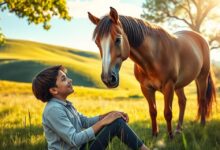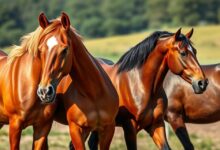Understanding Horse Markings: A Guide
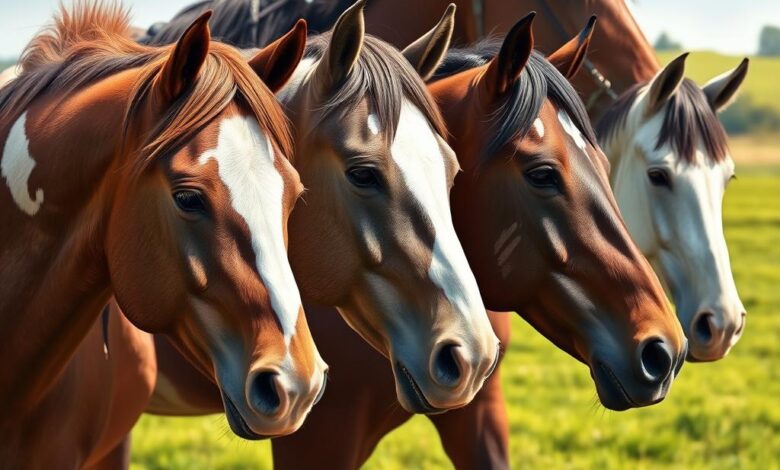
Ever wondered what horse markings say about their identity and heritage? We’ll explore how these unique traits are key in equine coat patterns and identification. Each horse’s look tells a story, shaped by complex horse color genetics. These genetics affect everything from breed to temperament.
Horse identification has changed a lot over time. From the early 1800s’ heated brands to today’s RFID technology, it’s come a long way. We’ll look at the importance of these markings, including facial, body, and leg patterns. They help tell one horse apart from another. Knowing about these markings shows us the beauty and history of horses in our care.
Key Takeaways
- Horse markings are critical for identification and breed characteristics.
- Facial, leg, and body markings contribute to distinguishing individual equines.
- Modern identification methods have evolved from branding to RFID technology.
- Understanding horse color genetics helps in appreciating various equine coat patterns.
- Horse markings can indicate ancestry and reinforce ownership validation.
Introduction to Horse Markings
Horse markings are patterns of white hair on a horse’s coat. They help us tell horses apart, especially when they look similar. It’s important to notice these unique features.
What Are Horse Markings?
Horse markings are any special patterns of white hair. Common ones are blazes, snips, and socks. These markings help us tell horses apart.
For example, most chestnut young stallions have white markings at birth. These markings stay the same as they grow older. They can also show a horse’s genetic makeup and family history.
Importance of Horse Markings
Markings are key in breeding and registering horses. They prove ownership and protect against theft. Knowing about these markings helps us understand a horse’s past and health.
Research shows that certain markings are linked to a horse’s genes. For example, the W20 allele is connected to white facial and leg markings. Markings can also change over time, especially after injuries. This shows how a horse’s looks are tied to its health.
Types of Horse Markings
Horse markings are key to identifying and categorizing these amazing animals. We see three main types: facial markings, body markings, and leg markings. Each type has its own special features that help us recognize horses.
Facial Markings
Facial markings are crucial for a horse’s identity. They come in many forms. Common ones are:
- Star
- Snip
- Stripe
- Blaze
- Bald Face
These markings are important for tracking a horse’s lineage and health.
Body Markings
Body markings are less noticeable but still key for identification. Common ones include:
- Dorsal Stripe
- Spots
The dorsal strip is common in mustangs and some pony breeds. Each marking makes a horse unique.
Leg Markings
Leg markings are vital for showing a horse’s height and pattern of white hair. They can be:
- Coronet
- Pastern
- Sock
- Boot
- Stocking
Horses can have one to four socks on their legs. This makes them stand out. Knowing these markings helps in identifying horses well.
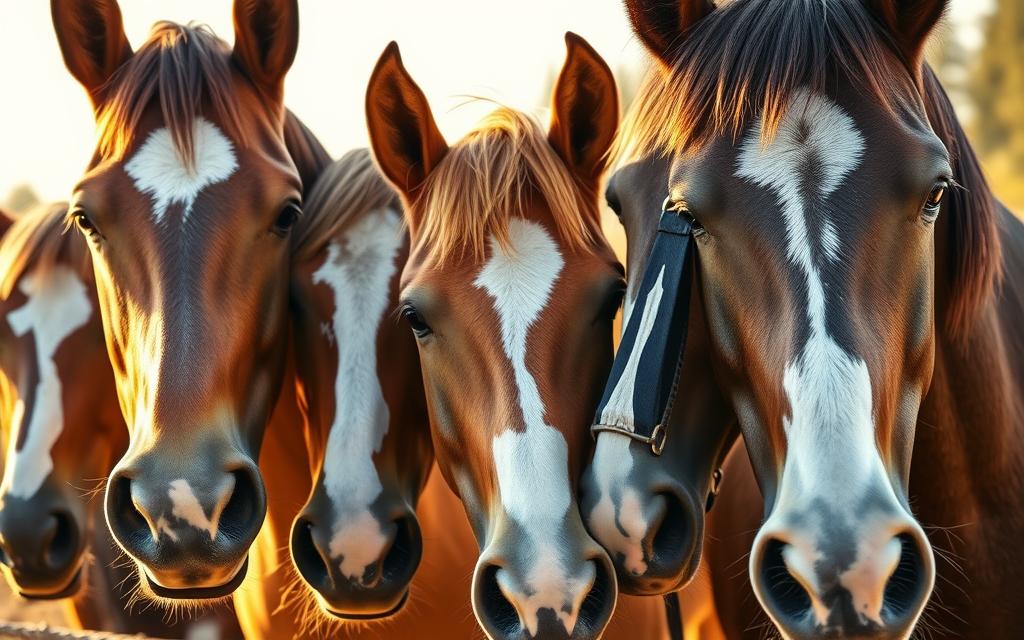
Common Horse Marking Patterns
Learning about common horse marking patterns deepens our understanding and appreciation of these animals. Each pattern has its own special traits, making each horse unique. Knowing horse marking terms is key for anyone involved in horse activities.
Blaze
The blaze is a clear white stripe on a horse’s face. It’s wide and vertical. This mark is often seen in breeds like Clydesdales and Appaloosas, making them stand out.
Stripe
A stripe is thinner than a blaze and goes straight down the face. It’s common in Morgans and Standardbreds. Stripes come in different sizes, making each horse’s look special.
Sock
A sock marking is a white patch on a horse’s lower leg. It goes up a bit. You see it a lot in Quarter Horses and Paints. These markings are not just pretty; they help identify horses in competitions.
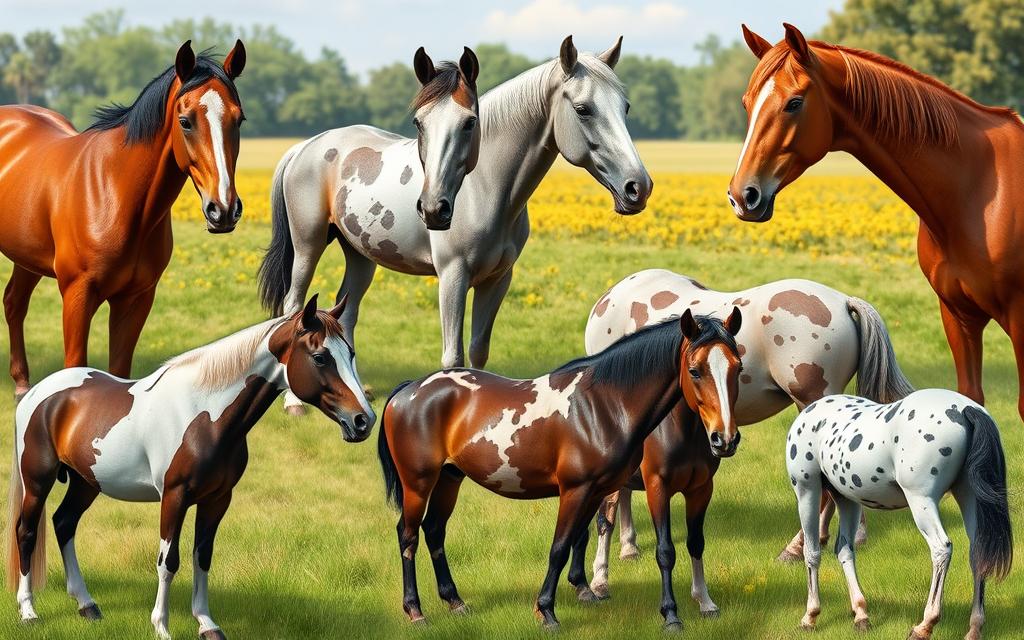
Distinguishing Markings from Breed Characteristics
Understanding how horse markings relate to breed traits can deepen our appreciation for horse diversity. Markings can hint at a horse’s breed, but many traits are unique to certain breeds. This section looks at breed-specific markings and how they show a horse’s ancestry.
Breed-Specific Markings
Certain breeds have unique markings that make them stand out. For example:
- Paint horses often have extensive white markings that highlight their color patterns.
- Quarter Horses have notable facial markings that make their profile easy to recognize.
- Friesians, ranging in height, are known for their black coats and white markings.
These markings are not just for looks; they’re crucial for identifying a horse’s breed. Horse color genetics play a big role in these patterns, making each horse unique within its breed.
How Markings Reflect Ancestry
Markings on a horse can tell us a lot about its ancestry. Genetics, like specific alleles, affect how markings appear. For instance, the W20 allele is linked to white face and leg markings.
Understanding these genetics helps us trace a horse’s lineage through its looks. Each horse has unique markings that connect them to their ancestors. This knowledge helps breeders make better breeding choices. It also shows the importance of these traits in equestrian sports, like horses with distinctive facial markings.
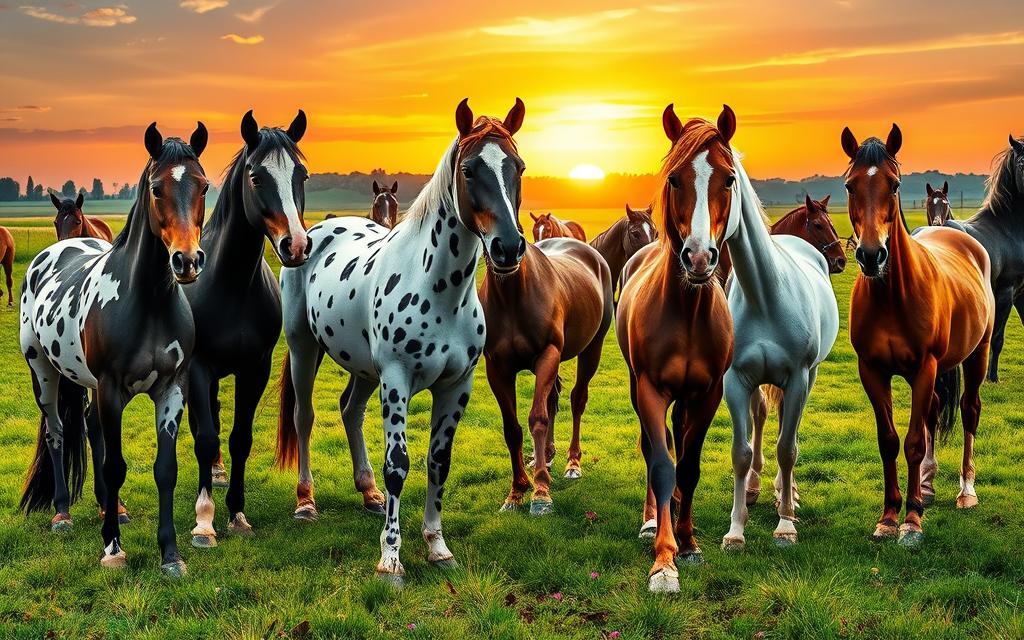
Reading Horse Markings
Understanding horse markings is key to identifying individual horses. Each horse has unique markings that help in various situations, like registration and sale. By observing these traits, we can spot and document what makes each horse special.
Identifying Unique Traits
Spotting unique horse markings helps us tell horses apart. For instance, Chestnut horses often have more white markings than bay or black ones. Horses with the W20 allele usually have white on their face and legs, making them stand out.
These markings not only make horses look beautiful but also show their genetic background.
Documenting Markings
Documenting horse markings is crucial for accurate identification. Breed registries often have rules about markings, making detailed records important. Markings like the Bald Face and Coronet are key identifiers.
Other markings, like Socks and Stockings, add to a horse’s unique look. Keeping track of these markings helps avoid mistakes and ensures correct identification for breeding, sale, or ownership.
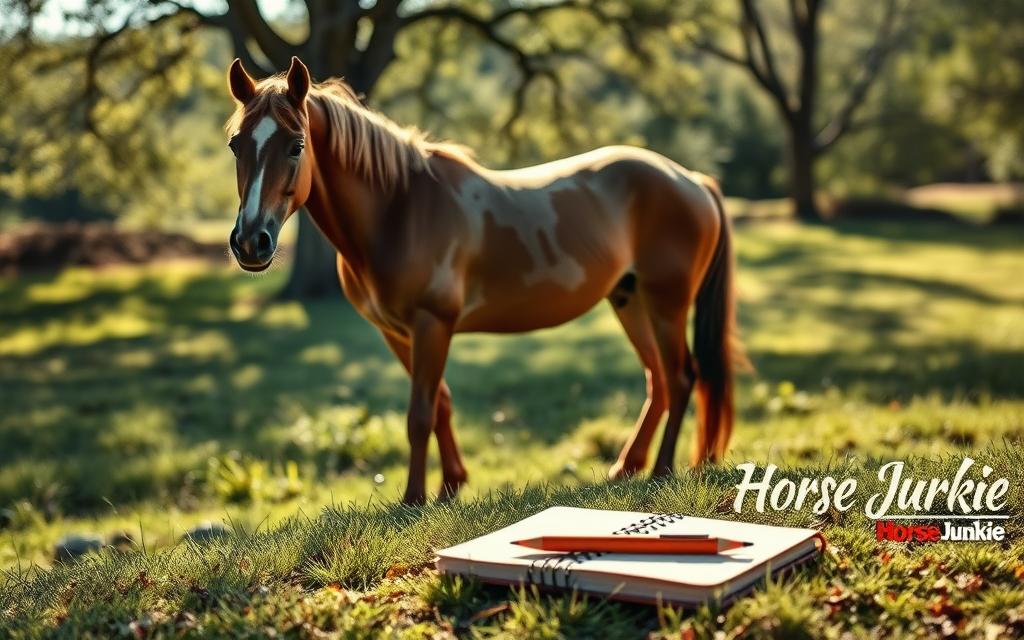
Genetic Origins of Horse Markings
Horse markings are a wonder to many. They fascinate horse lovers and breeders. Learning about their genetic roots helps us understand how these patterns form.
Specific genes control these markings. They pass on these traits from one generation to the next. This shows how genetics shape horse colors and patterns.
Role of Genetics
Many genes work together to create horse markings. Over 300 genes affect mammalian pigmentation, and more are still unknown in horses. The MC1R gene is key, with three main types: E, e, and ea.
These types affect the production of red and black pigments. The ASIP gene also plays a part, controlling where black pigment goes. Its dominant allele limits pigment to points, while the recessive allele spreads it evenly.
Inheritance Patterns
Studying inheritance patterns helps us guess what markings a horse might have. Tests can check for basic colors and specific traits like Agouti and Red Factor. Six genes—Cream, Champagne, Dun, Pearl, Silver, and Mushroom—change how pigmentation looks.
White spotting genes create unique patterns like Roan, Gray, Appaloosa, and Dominant White. These genes help us understand the beauty of horse colors and patterns.
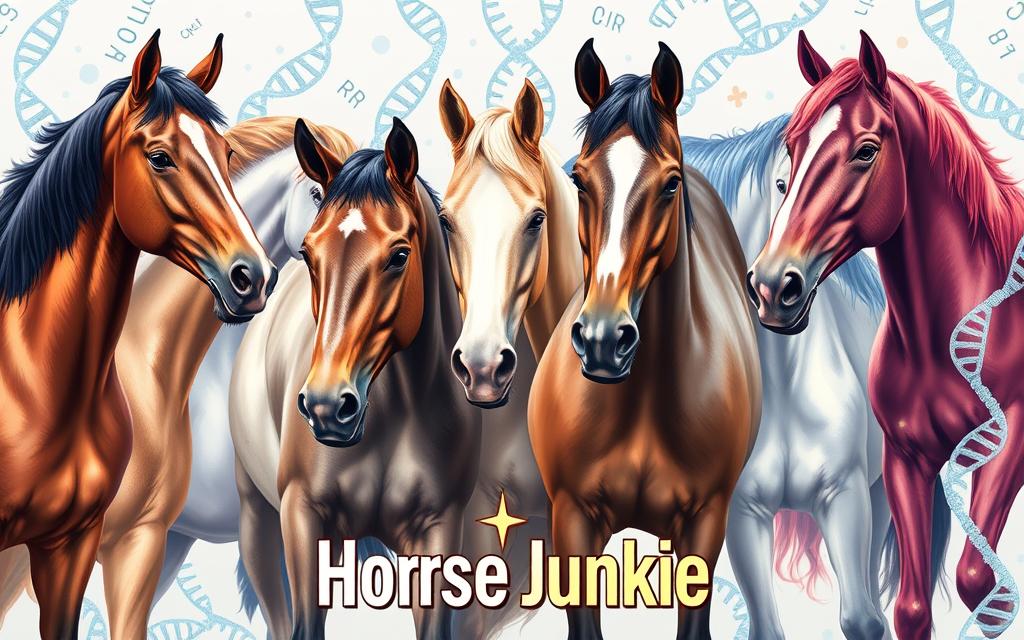
Markings and Horse Identification
Horse markings are key in identifying and registering horses. They help make sure each horse is unique. This lowers the chance of mistakes in who owns a horse and helps keep breed registries honest.
Importance for Registration
Registering a horse’s markings is very important. When we register a horse, we need to list their markings. This is to follow rules and make sure everything is correct.
Details like facial marks, leg marks, and special strips on the back are important. They help make a clear description of the horse. This is crucial for keeping the horse’s registration up to date.
- Facial markings such as stars and blazes
- Leg markings like socks and stockings
- Dorsal or eel strips commonly found on certain breeds
Every detail is important for a clear description. We use block capitals and clear writing. This makes sure everyone can understand the horse’s markings during registration.
Tracking and Legal Identification
Tracking horse markings is key for legal reasons too. DNA testing and blood typing are ways to confirm a horse’s identity. New methods like iris scanning are also being used.
The Jockey Club and Quarter Horse Association require these methods. They show how important they are in the horse world today.
Freeze branding is another way to mark horses. It’s safe and leaves a visible mark. This adds more security to horse identification. It helps us keep accurate records and build trust in who owns a horse.
![]()
Horse Markings in Health and Care
Understanding horse markings is key in horse care. These markings are important horse health indicators. They help us spot health issues early.
Markings as Indicators of Health
Horse markings are more than just looks. They tell us a lot about a horse’s health. Changes in these markings can mean there’s a health problem.
By watching our horses’ markings closely, we can catch health issues early. This lets us act fast to help them.
Recognizing Changes in Markings
It’s important to regularly check our horses’ markings. This helps us spot any unusual changes. Look out for changes in color or new patterns.
By staying alert to these changes, we can keep our horses healthy. We can also get them the care they need quickly.
Training and Working with Markings
Understanding horse markings is key in our training and bond with them. By using markings in our training, we improve communication and strengthen our connection. Recognizing a horse’s unique signs helps us tailor our training, making it more effective and fun.
Markings in Training Techniques
Using horse markings helps us communicate clearly. Their distinct signs act as visual cues, helping the horse understand us. When we notice and respond to their markings, they feel valued and respected.
This approach speeds up learning and helps us guide the horse better. It makes our training sessions more successful and enjoyable for both of us.
Building Trust Through Recognition
Trust is the foundation of effective training. By valuing a horse’s markings, we build trust. This mutual understanding makes horses more likely to follow our cues.
Our dedication to recognizing their unique signs creates a safe and respectful environment. This leads to better performance and overall happiness for the horse.
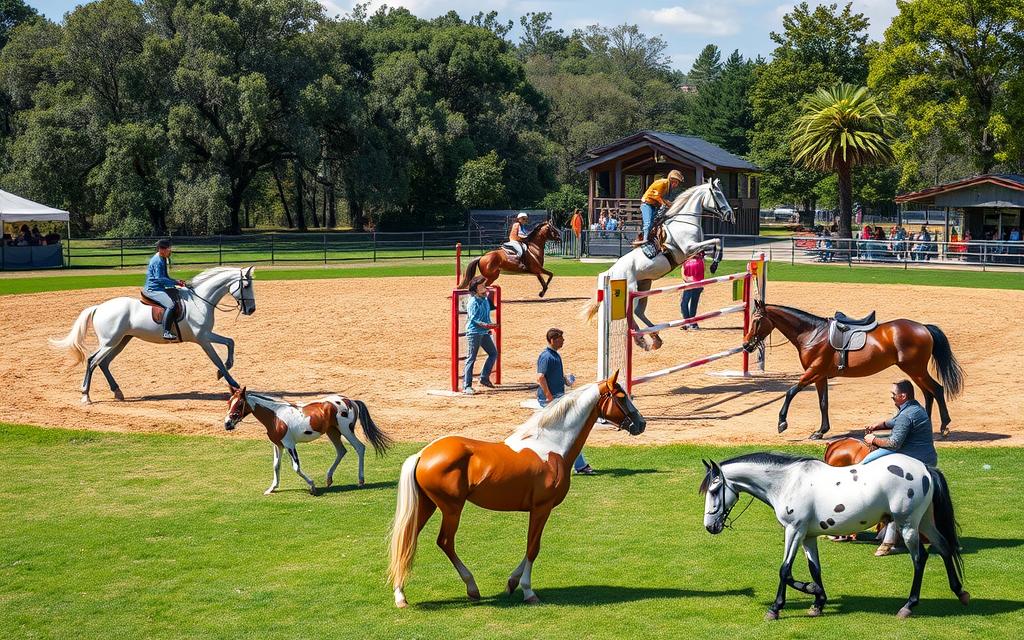
Conclusion: Appreciating the Beauty of Horse Markings
As we wrap up, we see that horse markings are more than just identification. They are beautiful ways to show each horse’s unique self. They celebrate the diversity in the horse world.
From the special white markings on sorrel horses to the patterns in different breeds, each horse has its own story. These stories are told through their markings.
Celebrating Diversity in Equine Appearance
Learning about horse markings deepens our connection with these amazing animals. It also makes us appreciate their unique beauty more. Traits like blazes and stars on their foreheads are truly special.
As we learn more about these traits, we see how important they are. They help in saving breeds and studying genetics. This knowledge will shape how we understand horse markings in the future.
The Future of Understanding Horse Markings
The future of horse markings looks bright with new genetic research and a love for horse welfare. We’re excited for discoveries that will make us appreciate these traits even more. They will become even more precious in the world of equine beauty.
Let’s keep learning and sharing what we know. By doing so, we ensure these special markings are loved for years to come. Each horse’s unique pattern is a treasure to be cherished.
FAQ
What are the most common types of horse markings?
How do horse markings relate to horse breeds?
Why are horse markings important for registration?
Can changes in horse markings indicate health problems?
How can we learn to read horse markings effectively?
What role does genetics play in horse markings?
How can horse markings enhance training and communication?
Are horse markings relevant in legal ownership issues?
Source Links
- NVAP Reference Guide: Equine Identification | Animal and Plant Health Inspection Service
- Horse Face and Leg Markings
- Horse Markings: Your Cheat Sheet on What You Need to Know! –
- Horse markings
- Riding Equipment and Activities
- Horse Markings: Your Cheat Sheet on What You Need to Know! –
- H:H039H039S02.WPD
- Horse Face and Leg Markings
- Horse Face and Leg Markings
- Horse Face and Leg Markings: Your Perfect Cheat Sheet
- Horse Markings – Guide to Equine Beauty, Read Now
- Identifying Horses – White Rose Equestrian Center Blog
- Horse Markings – Guide to Equine Beauty, Read Now
- COLORS AND MARKINGS
- Horse Markings – Guide to Equine Beauty, Read Now
- Horse Face and Leg Markings
- Equine Coat Color Genetics
- Genes Determine a Horse’s Coat Color – Veterinary Medicine at Illinois
- Horse Markings: Your Cheat Sheet on What You Need to Know! –
- Microsoft Word – Identification of horses2007_print.doc
- Horse identification
- Know Your Horse Markings
- Horse Face and Leg Markings
- Identifying Horse Parts and Markings
- Horse Face and Leg Markings
- Horse Markings – Guide to Equine Beauty, Read Now
- The Beauty and Charm of the Sorrel Horse: An In-Depth Look into this S
- Sorrel Horse: Exploring the Unique Coat Color in Equines


